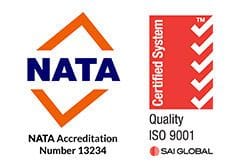Dust & Silica Monitoring & Services
All employers are under a general duty to provide a safe workplace. A dusty work environment is known to be linked to chronic respiratory health issues. There are two general types of dust:
- Inhalable Dust - is the fraction of airborne material greater than 10 microns in size, which enters the nose and mouth during breathing and it is therefore liable to be deposited in the upper the repertory tract.
- Respirable Dust - is the fraction of dust particles less than 10 microns in size, that penetrates deep in the lungs where gas exchange takes place.
Silica (SiO2) is a naturally occurring widely abundant mineral that forms the major component of most rocks and soils. There are non-crystalline and crystalline forms of silicon dioxide. In dry form, only fine crystalline silica constitutes a chronic respirable dust hazard, since its inhalation as airborne dust could give rise to silicosis and lung cancer. The non-crystalline form of silica does not cause this kind of lung damage.
There are recommended limits for employee exposure to inhalable dust and respirable dust, fibres, and crystalline silica. There is no specific recommended exposure limits for non-specific respirable dust, however the position paper from the AIOH suggests an exposure limit that is commonly used. If it is suspected that employees may be exposed to excessive dust levels, monitoring will confirm the exposure and assist in identifying problem locations and developing control strategies.
Within the Victorian Occupational and Health and Safety Regulations released in November 2021, extra requirements have been mandated for stonemasons, along with businesses working with products containing crystalline silica.
For stonemasons the business will need to apply for an engineering stone licence. Some of the requirements for this include undertaking atmospheric monitoring, providing control plans and documented risk assessments, and providing training for employees in the correct use of respiratory protection along with the risks involved with the tasks conducted and the control measures implemented. A 1 year transitional period between November 2021 and November 2022 has been set up to enable businesses to develop control plans to apply for licences.
For businesses working with products containing crystalline silica, if dust is generated from these products which expose employees to more than half the exposure standard, it is classed as high risk crystalline silica work. For all high-risk crystalline silica work, a hazard control statement must be prepared which outlines the works to be conducted, states hazards and risks and how the control measures will be implemented. This will come into effect in May 2022.
Businesses who mine or produce products with crystalline silica need to list a percentage content of crystalline silica on the safety data sheet, along with the name and contact details of the manufacturer or importer to be provided to purchasers of the product.
HAZCON can assist you to:
- Conduct personal inhalable and respirable monitoring to assess your employees' individual or Similar Exposure Groups (SEGs) dust exposure to help inform any risk assessments conducted.
- Conduct static (fixed) inhalable and respirable monitoring at strategic locations to assess environmental dust levels.
- Conduct real time (process specific) measurements of dust concentration using a Dust-Trak monitoring instrument, to determine dust levels generated by specific processes or movements in the workplace.
- Analyse of samples for respirable crystalline silica.
- Analyse bulk samples for percentage crystalline silica to aid in developing a register for products used on your site, or provide the information needed for a safety data sheet.
- Guide you as to what action is required to reduce or eliminate dust levels to healthy and acceptable levels in your workplace.
- Provide training for employees on the hazards and control measures of various tasks involving crystalline silica to better inform risk assessments being conducted.
- Provide advice on required respiratory protection available and the type most suitable for the occupation and/or environment.
Additionally, depending upon the location and type of workplace, along with any chemicals that may be used during processes within your facility, further analysis may be needed to determine if any constituents of the dust may be having an impact on employee health. This can include additives used within processes on site, along with other sources such as lead or chromium dust from working on old structures. HAZCON can tailor and develop an assessment to determine employees exposure to ensure they do not exceed any workplace exposure standards.
All HAZCON occupational hygiene works and recommendations to clients are undertaken to provide guidance to employers as to their duties to comply with appropriate Victorian Legislation, relevant Australian Standards and best practice.
Dust monitoring is carried out in accordance with the:
- AS 2985-2009 Workplace atmospheres - Method for sampling and gravimetric determination of respirable dust;
- AS 3640-2009 Workplace atmospheres - Method for sampling and gravimetric determination of inhalable dust;
- WorkSafe Victoria Compliance Code: Managing exposure to crystalline silica engineered stone, February 2020.
And with reference to:
- Safe Work Australia Workplace Exposure Standards for Airborne Contaminants, December 2019.
- More information on the AIOH position paper for respirable dust can be found within the reference below.
- Australian Institute of Occupational Hygienists (2016) Position Paper - Adjustment of Workplace Exposure Standards for Extended Work Shifts
If you would like more information or a quote for dust assessment please Contact Us
Hygiene monitoring encompasses a host of areas that HAZCON has specific expertise, including;
Asbestos Air Monitoring
Synthetic Mineral Fibre (SMF) Monitoring
Occupational Hygiene Monitoring
Biaerosol (Mould, Fungi) Sampling
You maybe interested in Silica and Dust Awareness Training As of 15th May 2022 all workers/employees who are likely to be exposed to risks associated with high risk crystalline silica must undergo training. HAZCON has developed a short fun fact filled 2 hour Silica Dust Awareness Training program.





